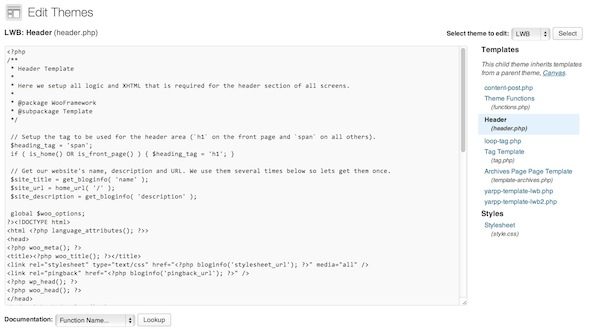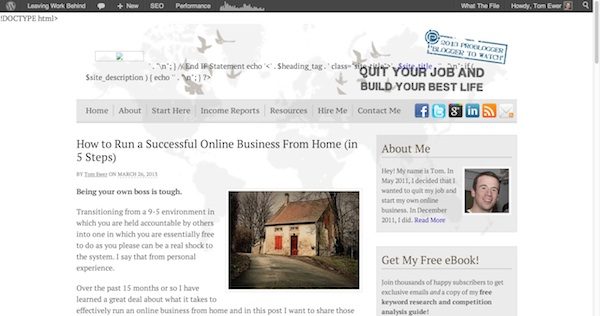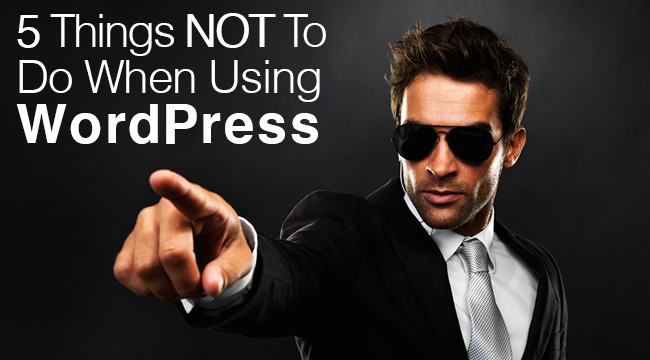El backend de WordPress puede ser un terreno peligroso para pisar como principiante. Cualquier cosa que ofrezca tal poder al mismo tiempo debe adjudicar responsabilidad al Username, que es donde algunas persons pueden equivocarse al comenzar.
Sin querer asustarlo demasiado, hay ciertas cosas que puede hacer en WordPress que simplemente lo romperán. En una nota menos preocupante (pero al mismo tiempo importante), hay otras cosas que puede hacer que sin lugar a dudas desaconsejaría, ya be que represente un riesgo potencial de seguridad o simplemente algo que tenga un impacto negativo en la experiencia del usuario.
Con lo anterior en mente, en este post quiero cubrir cinco cosas que debes evitar hacer en WordPress. Con las siguientes recomendaciones implementadas, su sitio Web será mucho más seguro, confiable, funcional y agradable para los visitantes.
1. Don't use code editors
There are a couple of landmines contained within the WordPress backend; You can access them through Appearance> Editor & Plugins> Editor in the sidebar.
At first glance, these editors are quite interesting - full access to your website's back-end! Imagine the possibilities.

Archivo de encabezado de mi Blog, al que se accede a través de del Editor de temas.
Imagine the possibilities actually - with one wrong keystroke, you can suddenly find your website good and really broken:

Solo tuve que quitar tres caracteres de los archivos PHP de mi tema para cambiar totalmente la apariencia de mi sitio web como se ve arriba.
But that's not the worst - it's very easy to accidentally disable access to your WordPress site's backend, leaving you with no immediate means to restore order to your site.
Debido a esto, le recomiendo que solo acceda y edite los archivos PHP de su sitio con una aplicación FTP how Filezilla (my personal favorite and (* 5 *) WordPress.org recommendation). You should make a copy of any PHP file you want to edit before you begin so that you can quickly revert to a working version in case it accidentally wreaks havoc on your site. Prevention is better than cure!
2. Don't keep deactivated themes installed
In my experience, there are three types of WordPress users:
- Those who handle a very tight ship
- Those who keep things reasonably neat and clean
- Those who have little regard for their site's backend
If you fall into the second or third type, you need to think carefully about the themes you have installed right now on your WordPress site. I am not referring to the active theme, but to the ones you have installed and deactivated.
Although those themes are disabled, they still exist in your WordPress installation and any security flaws or vulnerabilities can still be exploited. As an example, the most famous of the WordPress theme hacks is the TimThumb exploit, which continues to affect certain blogs to this day.
En términos generales, si utiliza temas de buena calidad y se asegura de que se mantengan actualizados, no debería tener ningún problema. Sin embargo, si tiene temas antiguos que no se utilizan en el backend de su sitio, mi recomendación sería eliminarlos de inmediato. Debido a su enorme escala de utilización, WordPress es un gran target para los piratas informáticos. No se convierta en un blanco fácil.
3. No utilice la funcionalidad de SEO de su tema
This recommendation is less a "you has to do this ”and one more suggestion that I highly recommend you follow.
Depending on the theme you have, you may find that it has SEO features built in. I advise you to avoid using these functions for two reasons:
- If you ever decide to change themes, the SEO data within your theme may be lost (or difficult to extract)
- The free (* 5 *) WordPress SEO by Yoast the plugin has the best SEO functionality of any plugin or theme available
It's a bold statement but generally accepted by some of the most respected users and developers in the WordPress community. As an example, as of October 31, 2012, WooThemes deprecated SEO functionality within their themes because SEO by Yoast is "more beneficial" for WordPress users. WooThemes handing over the reins of SEO to another developer is a bold sign of your faith in the Yoast plugin and an indication of how loved it is.
If you want to know more about Yoast SEO, check out our guide to common WordPress SEO mistakes.
4. Don't prolifically categorize or tag
There are few things that give me more embarrassment than misuse of categories and tags in WordPress.
Vamos a aclarar una cosa: las categorías y las etiquetas pueden tener un papel que desempeñar en su sitio web. Al contrario de lo que algunas personas creen, las etiquetas no son un tipo de taxonomía anticuado que no ofrece importancia en la era moderna de los blogs. A la vez, las categorías no están para ser usadas y abusadas.
My favorite definition of categories and tags comes from Lorelle:
Las categorías son la tabla de contents de su sitio. [and] las etiquetas son las palabras de índice de su sitio.
Now think about this: does the same text appear in a book in different chapters? Certainly not. This format should be transferred to your blog. What I mean by this is that a position should rarely be assigned to more than one category. If you feel the need to assign it to two or more, you probably have too many overlapping categories (7-10 is my rule of thumb for an optimal number).
Categories should represent the general topics covered on your blog (eg "dinner recipes") and tags should be more specific (eg "chicken"). Content should only be tagged when the tags in question are directly associated and relevant to the content. Generally speaking, I would say that you should only use no more than 50 tags.
My point is this: both categories and tags should be used to benefit the user. That is your main objective. If you lose sight of it, browsing your site will become a troublesome experience. At the very least, make sure your categories are clearly defined and well-stocked. If you're not sure how to label, read more about it or leave it alone.
5. Don't leave comment moderation on
I will end with a real hatred for my pet. There is nothing more frustrating for me when I blog when faced with the following message:

Si tiene que esperar a que su comentario sea moderado antes de que se publique, ¿se siente animado a comentar? ¿Te sientes valorado por el blogger? Supongo que la respuesta a ambas preguntas es no.
En mi opinión, la moderación de los comentarios representa una falta de respeto por parte del blogger por el tiempo del comentarista y debe evitarse a toda costa. Lo curioso es que habitualmente encuentras moderación de comentarios en blogs más pequeños; rara vez se usa en blogs más grandes (que probablemente reciban más spam). Yo especularía que se debe a que los blogueros más grandes saben que no deben enemistarse con sus seguidores más leales (dicho de otra forma, aquellos que comentan).
Actually, spam is not such a big problem: plugins like Akismet hacer un gran trabajo para detener la mayoría del spam. Escribí un artículo aquí en R Digital marketing sobre prevención de spam. Y cuando un blog crece y recibe muchos comentarios, moderar individualmente a todos y cada uno se convierte en una tarea innecesariamente enorme. Desactive la moderación de comentarios a través de de la pantalla Configuración> Discusión accesible desde la barra lateral.
What to do Your Recommend avoid?
Previously, I outlined five things I think you should avoid doing in WordPress, from serious security flaws to I hate pets. Of course, there are many more warnings and recommendations that could be made about using WordPress, so I want to open it up for you.
So tell us: what do you recommend we avoid doing in WordPress to keep our sites safe, easy, and enjoyable to use? Let us know in the comment section!






